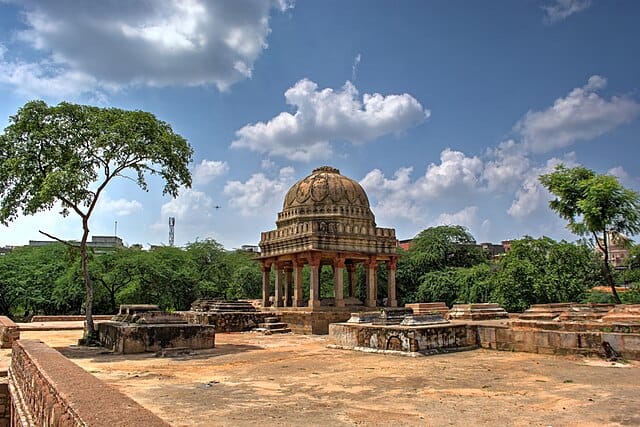Explore 7 iconic archaeological parks in India that preserve ancient history, architecture, culture, and civilisation.

Archaeological parks are the closest we have come to peeking into the past across the veils of time. These spaces offer visitors a rare opportunity to experience the past in its authentic setting, where natural beauty and human-made structures come together to tell the story of past civilisations; archaeological parks serve as open-air classrooms that reveal how societies, architecture, and culture have evolved over time. Here are 7 fascinating archaeological parks of India that you have to experience.
Warangal Fort Archaeological Park
Warangal transports visitors to the heart of the ancient capital of the Kakatiya dynasty. Sprawled across landscaped grounds, the park preserves the monumental remains of this 13th-century stronghold, originally constructed by King Ganapati Deva and later expanded by his daughter, the legendary Rani Rudrama Devi, and her grandson Prataparudra II. Warangal Fort is now equipped with an open-air museum that exhibits sculptures, inscriptions, and architectural elements recovered during excavations. These displays help visitors understand the linguistic, artistic, and historical dimensions of the region.
The fort played a central role as both a political and cultural hub, famously withstanding several sieges, including the notable attack by Malik Kafur of the Delhi Sultanate in 1309. Its iconic “Kakatiya Kala Thoranam” stone gateways and the intricate stonework throughout the site are enduring symbols of the dynasty’s architectural brilliance.
The complex displays a spirit of religious inclusiveness, housing temples devoted to deities such as Shiva, Vishnu, and Surya. Later additions include Islamic monuments and inscriptions. There are even elements that hint at Buddhist and Jain influences, seen in some of the sculptural motifs and carvings. The legacy of Rani Rudrama Devi, one of India’s rare female monarchs, adds to the historical significance of the site. She played a central role in completing the fort’s construction and in managing its defence and governance, reflecting progressive gender roles during her reign.
Artistically, the fort is a showcase of the Kakatiya dynasty’s patronage. Floral and geometric motifs, mythical creatures, and narrative friezes cover the structures, all representing a unique confluence of Dravidian and Nagara architectural styles.
Within the park, visitors can marvel at the four grand stone gateways, which stand lending a peek into the fort’s storied past. The ruins of ancient Shiva temples, particularly the Swayambhudevi Alayam, offer a glimpse into the spiritual life of the era. Massive granite walls, bastions, and moats evoke the fort’s formidable defences, while the open-air museum displays exquisitely carved sculptures and inscriptions that narrate the region’s history. Remnants of palaces, gardens, and fountains further enrich the experience, painting a vivid picture of royal life.
Reaching There
Reaching Warangal Fort is convenient, with Warangal city in Telangana serving as the nearest urban centre. The fort is easily accessible by train via Warangal Railway Station, which is well connected to Hyderabad and other major cities. For those travelling by road, the fort lies about 150 kilometres from Hyderabad, with regular buses and taxis available for the journey.
Nearby Attractions
The fort’s central location makes it an excellent base for exploring nearby attractions. The Thousand Pillar Temple in Hanamkonda is renowned for its ornate architecture and spiritual significance. The Ramappa Temple, a UNESCO World Heritage Site, is celebrated for its intricate carvings and floating bricks. Bhadrakali Temple, set beside a serene lake, is another must-visit for those interested in sacred sites.
Pro Tip
The best times to explore the park are early morning or late afternoon, when the light is ideal for photography and the atmosphere is more comfortable for walking.
Bidar Fort Archaeological Park
Bidar Fort Archaeological Park in Karnataka is a sprawling complex that stands as a testament to the region’s rich Indo-Islamic heritage and architectural innovation. Built in the 15th century by Sultan Ala-ud-Din Bahman of the Bahmani dynasty, the fort became the capital of the Bahmani Sultanate and later the Barid Shahi dynasty, serving as a vibrant centre of culture, power, and military ingenuity.
The fort’s design reflects a unique blend of Persian, Turkish, and Indian architectural styles, with its red sandstone structures, seven grand entrances, and 37 octagonal bastions equipped with metal-shielded cannons. The fort is built along the edge of the Deccan plateau with a distinctive rhombus-shaped layout that spans approximately 1.2 kilometres in length and 0.8 kilometres in breadth. One of its most unusual and significant defensive innovations is the triple-channelled moat system, introduced by Turkish mercenaries. This rare feature in India measures up to 43 feet deep and more than 100 feet wide at certain points.
The fort also features seven grand gateways, including the Mandu Darwaza, Sharza Darwaza, and Gumbad Darwaza. Each gateway was designed with strategic defensive features such as domes, arches, and spacious passageways capable of accommodating thousands of soldiers. The fort is further fortified with 37 octagonal bastions, many of which are still equipped with massive cannons, providing extensive visibility and defence capabilities. Constructed using locally sourced laterite and trap rock, the walls were bound with lime mortar. Intricate plastering, black stone elements, and ornate finishes are especially visible in the palatial interiors and prominent gateways.
Inside the fort, visitors can explore the ornate Rangin Mahal, renowned for its vibrant Persian tile work and intricate wood carvings, and the Solah Khamba Mosque, which is supported by sixteen pillars and admired for its simplicity and grandeur. The Gagan Mahal and Takht Mahal, along with lush gardens inspired by Mughal horticultural traditions, further showcase the opulence of the Bahmani era.
One of the fort’s most remarkable features is its ancient underground water supply system, known as the Karez. The Karez water system in Bidar, modelled on Persian qanats, features underground tunnels with vertical shafts that ensured a steady water supply in the arid Deccan region. Of the six known systems, Naubad Karez served the public, while Jamuna Mori Karez catered to the royal family. Today, this engineering marvel is under active restoration to preserve its legacy.
Reaching There
Beyond the fort, Bidar offers several nearby attractions, including the revered Gurudwara Nanak Jhira Sahib, the ancient Papnash Shiva Temple, and the impressive Bahmani Tombs, each reflecting the city’s diverse spiritual and historical legacy. Reaching Bidar Fort is convenient, with Bidar Railway Station providing connections to Hyderabad and Bengaluru, and the city is located just 140 kilometres from Hyderabad by road, with frequent bus and taxi services available.
Pro Tip
The best time to visit is between December and February, when the weather is pleasant for walking through the fort’s extensive grounds. Bidar Fort remains open daily from 9 AM to 5 PM, and entry is free, making it an accessible and rewarding destination for history enthusiasts and cultural travellers alike.
Champaner-Pavagadh Archaeological Park
Champaner-Pavagadh Archaeological Park, a UNESCO World Heritage Site, is one of Gujarat’s most fascinating historical destinations, set amid the dramatic landscape of the Panchmahal district. The park encompasses the remains of a medieval city, impressive fortifications, palaces, mosques, and the sacred Pavagadh Hill, which rises 800 meters above the plains and is crowned by the revered Kalika Mata Temple.
The site of Champaner was originally established in the 8th century by Vanraj Chavda of the Chavda dynasty, who named the city after his general Champa. The hill fortress at Pavagadh began as a Hindu stronghold and was later taken over in the 13th century by the Khichi Chauhan Rajputs. They fortified Pavagadh Hill and constructed temples along with effective water-retention systems.
In 1484, after a prolonged siege lasting 20 months, Sultan Mahmud Begada captured Pavagadh and declared Champaner the capital of the Gujarat Sultanate. He undertook extensive rebuilding and expansion of the city, which flourished until 1536 when the capital was moved back to Ahmedabad following the Mughal conquest. Champaner remains the only complete and unchanged Islamic pre-Mughal city in India, preserving its architectural and urban planning features from the late 15th and early 16th centuries without any later Mughal alterations.
As you explore the park, you’ll encounter the Jama Masjid, renowned for its soaring minarets, intricate latticework, and beautifully carved entrance porch that leads into a spacious courtyard. The mosque’s prayer hall features tall central minarets, multiple domes, and finely latticed windows, reflecting a unique fusion of Islamic and Hindu architectural elements. Pavagadh Hill is a major pilgrimage site, drawing thousands to the Kalika Mata Temple, especially during Navratri. The hill itself offers panoramic views of the surrounding countryside, and visitors can either climb the steps or take a ropeway to the summit for a memorable experience.
The park is dotted with ancient fort walls, stepwells, palaces, and a remarkable collection of Jain temples and Hindu shrines, each bearing witness to the region’s layered religious and cultural history. The living village of Champaner at the base of the hill adds to the site’s vibrant atmosphere, and the area’s archaeological treasures include water-retention systems, agricultural structures, and residential complexes that span centuries of settlement.
Nearby Attractions
Nearby, you can visit the Jambughoda Wildlife Sanctuary, known for its lush forests and wildlife, or head to Vadodara city to explore the grand Laxmi Vilas Palace and other attractions. Champaner-Pavagadh is located about 50 kilometres from Vadodara, which serves as the nearest city and transport hub. Vadodara Railway Station is well connected to major cities, and buses and taxis provide easy access to the park.
Pro Tip
When visiting, plan to arrive early in the morning to avoid crowds and the midday heat. Take time to admire the Indo-Islamic architectural details in the mosques, and don’t miss the chance to ascend Pavagadh Hill for breathtaking views and a glimpse of the region’s spiritual traditions.
Dholavira Archaeological Park
Dholavira stands out as one of the most prominent sites of the Indus Valley Civilisation, located deep within the Rann of Kutch in Gujarat. This ancient city, inhabited from 3000 BCE to 1500 BCE, offers a remarkable glimpse into the ingenuity of Harappan culture, especially in urban planning and water management. Visitors are often struck by the city’s sophisticated layout, featuring massive stone walls and grand gateways that once protected its inhabitants.
The site is renowned for its series of carefully engineered water reservoirs and channels, which demonstrate advanced techniques for harvesting and storing water in an arid landscape. Among its many unique features, Dholavira’s signboard with Harappan script remains an enduring mystery and a highlight for those interested in ancient writing systems.
As you wander through the ruins, you can explore the remains of houses, well-laid streets, and the imposing citadel that once stood at the city’s core. The on-site archaeological museum displays a range of artefacts unearthed from the site, adding depth to the story of Dholavira’s past
Reaching There
Reaching Dholavira requires some planning, as the nearest town is Bhuj, about 220 kilometres away. Bhuj Railway Station serves as the main rail link, and from there, taxis or buses are available to take you across the stark yet beautiful landscape to the site. For the most comfortable experience, plan your visit during the winter months from November to February, when the weather is pleasant for exploring. It’s important to carry plenty of water and sun protection, as Dholavira is remote and the climate can be harsh. While at the site, take time to observe the unique Harappan signboard and the intricate water systems, which stand as a testament to the advanced knowledge and resilience of this ancient civilisation.
Nearby Attractions
The surrounding region offers striking natural attractions such as the Great Rann of Kutch, famous for its vast salt desert, and the Kutch Desert Wildlife Sanctuary, home to unique flora and fauna.
Mehrauli Archaeological Park
Mehrauli Archaeological Park in South Delhi is a remarkable green expanse, offering a journey through more than a thousand years of Delhi’s layered history. Spanning over 200 acres, this unique park features monuments from the Rajput, Sultanate, Mughal, and British periods, making it the only area in Delhi known for such long-standing, continuous occupation. The park is adjacent to the iconic Qutub Minar complex and contains over 100 historically significant structures, including tombs, mosques, stepwells, palaces, and the remains of the ancient Lal Kot fort, built by the Tomar Rajputs in the 11th century.
As you explore, you’ll encounter the Jamali Kamali Mosque and Tomb, celebrated for its Indo-Islamic architecture and intricate decorative details, and the Rajon ki Baoli, a beautifully designed stepwell with arched niches and symmetrical steps that once served both practical and social functions. Other highlights include Balban’s Tomb, notable as the first structure in India to feature a true arch and dome, and Metcalfe’s Folly, a relic of the British era that reflects the eclectic history of the site. Scattered throughout the park are numerous lesser-known ruins, gardens, and pleasure pavilions, many of which are enveloped by lush vegetation, offering a sense of discovery at every turn.
Nearby Attractions
Nearby attractions include the UNESCO-listed Qutub Minar, the vibrant Hauz Khas Village, and the modern architectural marvel of the Lotus Temple. Mehrauli Archaeological Park is easily accessible via the Qutub Minar Metro Station on the Yellow Line or by taxi and auto-rickshaw from anywhere in Delhi.
Pro Tip: Try to avoid visiting during the summer months, delhi is known for its recurring heatwaves and extreme heat.
Sisupalgarh Archaeological Park
Archaeological studies place the founding of Sisupalgarh as early as the 7th–6th centuries BCE, predating the Mauryan era, with habitation continuing until around the 4th century CE Recent excavations (2005–2009) using geophysical surveys and laser scanning have revealed the southern moat’s position, multiple construction phases of the ramparts, and a large apsidal structure near the central pillar area, suggesting monumental public architecture
The city covered approximately 130 hectares (over 1 km²), with ramparts reaching up to 9 m high and eight formal gateways, two on each side. Designed on a perfect square, the inner layout featured wide streets, guardhouses, broad avenues, pedestrian-friendly paths, grain tanks, and reservoirs; elements characteristic of today’s smart cities.
Estimates suggest a population of 20,000–25,000 people living within the fortified area, twice the population of classical Athens. Charred rice grains and fish bones unearthed indicate a diet based on agriculture and fishing, while rice-husk impressions on bricks point to local production in areas supplying the city.
Sisupalgarh also contains a monumental stone pillar complex often referred to as the “pillar mound” or Shola Khamba. Excavations uncovered more than the previously known fourteen pillars, arranged in a circular or apsidal formation, indicating large ritual or public gatherings supported by a formal precinct.
Despite its archaeological importance, the site faces significant preservation challenges. Encroachment from illegal housing, overgrowth, vandalism, and loss of artefacts uncovered in earlier excavations threaten its integrity
Reaching There
Sisupalgarh lies just five kilometres from Bhubaneswar. The city is well connected by train via Bhubaneswar Railway Station, and local taxis and buses provide easy access to the site. For the most comfortable experience, plan your visit during the cooler months from October to March. Exploring Sisupalgarh with a knowledgeable local guide is highly recommended, as they can provide valuable historical context and help you navigate the ongoing excavations and areas that may be restricted.
General Tips for Visiting Archaeological Parks:
- Hire a knowledgeable guide or use an audio guide for deeper insights.
- Respect site rules and avoid touching or climbing on ruins.
- Carry water, wear sun protection, and dress comfortably.
- Check for entry timings and ticket requirements in advance.
Read More: Latest



